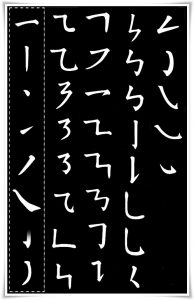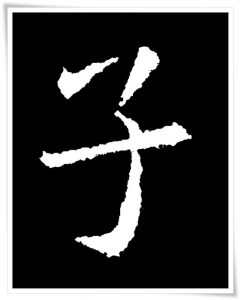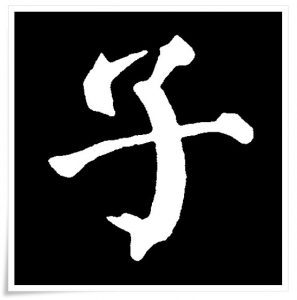Part I, Part II(a), and Part II(b) of this series about brush techniques described arm positioning principles (腕法, わんほう, wanhō, i.e., the way the arm is utilized while holding a brush) and brush holding principles (執筆法, しっぴつほう, shippitsuhō, i.e., the position of fingers on the brush axis), respectively. In this article I will discuss brush operating principles (用筆法, ようひつほう, yōhitsu hō), i.e. the way in which the brush is controlled by the arm, wrist and finger, allowing the calligrapher to write a desired line.

Practicing various brush operating principles is essential for mastering various scripts and calligraphy styles. Brush operating techniques vary for each of the five major scripts. Additionally, each calligrapher holds and operates the brush in either a slightly or a fundamentally different manner, thus, every calligrapher’s handwriting is delivered via various methods. Consequently, in order to learn and understand calligraphy classics (古典,こてん, koten) in detail, which is crucial for developing personal style (so called shofu {書風, しょふう, shofū} in Japanese), one must learn brush operating methods.
Since there are many brush operating techniques, I will separate the detailed descriptions into several articles. In this part I would like to talk about the basics of brush operating methods, which are:
- 起筆(きひつ、kihitsu, lit. “brush awakening”), also known as 始筆 (しひつ, shihitsu, lit. “brush beginning”) or 落筆 (らくひつ, rakuhitsu, lit. “coming down with the brush). This method tells us how to position the brush on the paper in order to begin a stroke.
- 送筆(そうひつ, sōhitsu, lit. “sending the brush {onto the paper surface}”). This method tells us how to operate the brush while writing a calligraphy stroke, from its beginning to its end.
- 収筆(しゅうひつ、shūhitsu, lit. “finishing or restoring the brush {to its former position}), which is also known as 終筆 (しゅうひつ、shūhitsu, lit. “finish of the brush {stroke}). This method defines the ways of lifting the brush off of the paper surface in order to finish the stroke.

Each Chinese character is composed of strokes. There are 37 types of strokes in standard script (楷書, かいしょ, kaisho) (see Figure 1), although of those, 8 of them are the absolutely fundamental. The latter are known as the “Eight Principles of the Character 永 (えい, ei, i.e. “eternity”)”, which theory was created by a Sui dynasty (隋朝, pinyin: Suí cháo, 581 – 618 C.E.) calligrapher named Zhi Yong (智永, pinyin: Zhì Yǒng, exact birth and death dates are unknown). The detailed explanation of those is on our shodopedia page (linked above). Also, you can see those 8 strokes distinguished in the Figure 1 by a dotted line. Lastly, each of those strokes has its beginning, middle and end, which corresponds respectively with the above points 1 and 3.
The way in which the brush is applied onto the paper surface, the way the stroke is executed, and the way it is lifted, define the calligraphy line of each script, style or personal handwriting. In other words, the skilled eye of a calligrapher can determine which technique was used during writing by observing the individual strokes or the calligraphy work as a whole. This is why it is so important to have a knowledgeable and experienced calligraphy teacher who can explain which technique is to be used during studying given calligraphy classics, and what the disciple should pay attention to while executing it. The quality of the line has creative power over our calligraphy, and it cannot be achieved without comprehending how to properly operate the calligraphy brush.

There are many variants of each of the three basic brush operating methods. For instance, the “brush awakening” in clerical script (隷書, れいしょ, reisho) will be completely different than in oracle bone script (甲骨文, こうこつぶん, kōkotsubun) or standard script (楷書, かいしょ, kaisho). Then again, if you compare the handwriting of Ouyang Xun (歐陽詢, pinyin: Ōuyáng Xún, 557 – 641 C.E.) (Figure 2) with that of Yan Zhenqing (顔真卿, pinyin: Yán Zhēnqīng, 709 – 785 C.E.) of the (Figure 3), both in standard script, you will notice a colossal contrast in the execution of the strokes. This means that the brush operating techniques of those two great Masters, who lived in the same historical period of the Tang dynasty (唐朝, pinyin: Táng Cháo, 618 – 907 C.E.), were completely different. Yan Zhenqing’s “sending the brush” technique was very dynamic, heavily dependent on the skillful operation of the brush tip, whereas Ouyang Xun’s standard script was aiming at precise and surgically structured and perfectly balanced brush strokes, as if he were designing the characters, not writing them. Both handwritings are highly valued by calligraphers for different reasons, and each style is the result of how they handled their brush.
Ending the brush stroke is as important as beginning it and writing it. A too hastily removed brush may cause the line to lose its power and charm. A delayed removal may result in an undesirable blur or bleeding. A true Master calligrapher is able to enchant the paper surface effortlessly, his brush barely touching the paper surface, yet producing spiritually rich lines. The observer may think that it was written rapidly, whereas in fact it was written slowly and carefully. Of course, the full power of the brush stroke does not come from the way in which one operates the brush physically, but rather how well it is attuned to one’s soul, and the understanding of this art. The greatest Masters spend their lifetime practicing not their arm techniques, but offering their souls to the art of calligraphy. In other words, clear and powerful brush strokes mirror their purity of mind and complete emotional and aesthetical immersion.
